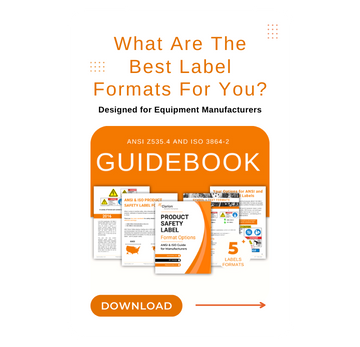The Evolution of Safety Sign Technology
Over the past 100 years, what’s considered “state-of-the-art” for safety signs has undergone significant change. Yet, most safety signage used in the U.S. today is still based on antiquated, 70-year old standards; people in charge of OH&S risk reduction for organizations need to understand this and change over to what is considered to be today’s best practices in risk communication. In 2013, OSHA recognized the superior safety communication attributes of the latest ANSI safety sign standards by updating its regulations to include references to the newer ANSI Z535 standards. Even though OSHA allows businesses to continue to purchase and use the 1941-era signage, it now encourages the use of the most current ANSI standards for safety signs and tags, the kind of signs and tags Clarion Safety supplies, so companies like yours can stay in step with today’s best practices in risk communication.
How have safety signs evolved over the past 100 years?
See our timeline of safety sign best practices.
Safety Signs Compliant with the Latest Best Practices are Here
Clarion Safety’s sign systems are different – they incorporate the most current ANSI and ISO design features that enable people to better identify and avoid hazards, locate emergency equipment and find egress routes in times of crisis. With the safety of your workforce and reputation of your company on the line, it’s time to update your safety sign system to reflect today’s more communicative standards.
Old, Outdated Signs |
Today’s Best Practice Signs |
|
|---|---|---|
| Hazard Alerting | Lack substantive information | Show more information, helping people to make better, safer decisions |
| Symbols | Do not use symbols | Use graphical symbols to communicate across language barriers |
| Format | Use 1941-era formats | Use the new, colorful ANSI formats to attract attention |
| Signal Words | Often use signal words inappropriate to the level of risk | Use proper risk level signal words |
Direct Comparison of Sign Types - Outdated vs Today's Best Practice

A Closer Comparison of New vs. Old Signage
Clarion Safety’s new, best practice signs use nationally and internationally standardized elements to better convey safety messages in today’s workplaces. Let’s take a look at the specific components of Clarion Safety’s best practice signs – and where old, outdated signs fall short.
Clarion Best Practice Signs |
The Alternative |
|
|---|---|---|
| SAFETY ALERT SYMBOL | ✓ Used consistently to indicate potential personal injury. |
✗ Fails to use. |
| SIGNAL WORDS | ✓ Use proper term and color coding to properly identify hazard alerting safety messages, non-hazard alerting safety messages, and instructional safety messages. |
✗ Often fails to use appropriate term and color coding for the level of risk. |
| WORD MESSAGES | ✓ Identify hazard alerting safety messages, non-hazard alerting safety messages, and instructional safety messages. |
✗ Fails to provide substantive information to understand the hazard. consequence of interaction with the hazard and how to avoid the hazard. |
| GRAPHICAL SYMBOLS | ✓ Globally formatted symbols communicate across language barriers and bring added noticeability. |
✗ Fails to use |
| STANDARDS | ✓ Based on the latest ✔ standards-based best practice design methodologies (ISO and ANSI - which is accepted by OSHA). |
✗ Based on antiquated 70-year old standards. |
| SYSTEMS APPROACH | ✓ Each sign, label, tag and marking is designed to be part of an overall system of safety communication meant to reduce risk and promote safe work behaviors. |
✗ Are often a cluttered.. ad-hoc, non-uniform assortment of different signs and formats. |
The Benefits of Best Practices
All of these aspects of best practice safety signage listed above serve these two goals:
1. To better protect people from harm:
By visually reinforcing safety training and better communicating safety to guests, subcontractors, and temporary workers, the new sign formats are aimed at helping to achieve fewer workplace accidents and injuries.
2. To better protect your company from litigation:
The new sign formats represent the “state of the art” for visual safety communication technology. Properly using them will provide your company with a better defense in court should an accident occur and a lawsuit arise.
Clarion Safety’s “Systems” Approach
Implementing state of the art risk communication in your workplace is about selecting safety signs, labels and tags that comply with the latest ANSI and ISO best practice standards. It’s also essential to understand that, with Clarion Safety’s approach to safety, each sign, label, tag and marking in your facility is part of a “system” of safety communication meant to reduce risk and promote safe work behaviors. Consistent use of the latest standards-based design principles for symbols, color-coding, formatting and message content throughout that system is crucial to achieving effective risk reduction.
Diagram Demonstrating how Signage 'Systems' Work Together to Reduce Injury and Liability
.png)
Are You Interested in a Best Practice Safety Sign System?
Learn More About How a Clarion Safety Sign System can Improve Safety and Reduce Liability in Your Facility.
